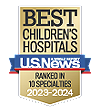NICU sims ensure labor and delivery team is expertly prepared for complex deliveries.

In the critical first moments of life, the neonatal labor and delivery care team’s readiness can mean the difference between life and death. At Lucile Packard Children’s Hospital Stanford, an innovative simulation program ensures that this team is prepared for anything.
Recently, more than 40 staff members took part in an open house for the NICU Simulation Station, which was developed by Audrey Moore, a board-certified neonatal nurse practitioner (NNP), NNP lead of the Resus One Resuscitation Safety and Performance Improvement Program, and designer of the NICU Simulation Station at Packard Children’s Hospital. ”Simulation allows participants to develop or enhance their knowledge, skills, and team performance in anticipation for critical situations in the delivery room,” Moore says.
The NICU Simulation Station, funded by a grant from the Association of Auxiliaries for Children, is unique in that it allows teams to practice technical skills prior to all deliveries and just-in-time training prior to complex deliveries.



Founded in 2018, the Resus One Program was developed by neonatologists at Packard Children’s Hospital to improve patient safety by analyzing team performance in the delivery room. With the addition of the NICU Simulation Station, all of the health care professionals involved in the care of newborns at the time of birth (neonatal nurse practitioners, NICU nurses, respiratory therapists, neonatology hospitalists, neonatologists and trainees, such as residents and fellows in these disciplines) now receive critically important training on a daily basis.
Just-in-time training and briefing is now done to prepare for both routine and complex delivery room situations, allowing teams to prepare for patients such as those born at the limits of viability (barely halfway through a 40-week pregnancy) and full-term neonates with congenital malformations that complicate their resuscitation and stabilization. In every scenario, it’s crucial for the neonatology team to act swiftly and effectively to provide the patient with the best opportunity for an optimal outcome.
In just the first two weeks of operation, multiple neonatology teams participated in 28 pre-delivery briefings and just-in-time training sessions. In addition, health care professionals had more than 100 opportunities to practice life-saving interventions such as positive pressure ventilation and intubation.
“Given the many different combinations of individuals who come together to attend a complex delivery at any particular point in time, utilizing the simulation station for briefings, practice of technical skills, just-in-time training, and larger scale simulations ensures that each team member can perform at a high level when a newborn’s life is at risk,” Moore, says.
Lou Halamek, MD, Professor of Pediatrics, Director of Neonatal Resuscitation and founder of both the Resus One Program and the Center for Advanced Pediatric and Perinatal Education (CAPE) at Packard Children’s Hospital, is effusive in his praise for what Moore has accomplished with the support of the Resus One team, which includes Nicole Yamada, MD, Medical Director – Neonatal Critical Care Transport Team, and Janene Fuerch, MD. Medical Director – Neonatal ECMO Director.
“Audrey Moore has worked incredibly hard to bring this Simulation Station to everyone in the NICU,” says Dr. Halamek. “It is an important component of Resus One and the CAPE Circle of Safety, where real-world human performance data drives our training efforts. Her vision, dedication and tenacity have created a tool that will literally help save newborn lives.”
Authors
- Julienne Jenkins
- more by this author...


 Previous
Previous







